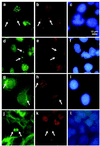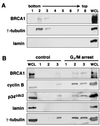BRCA1 is associated with the centrosome during mitosis
- PMID: 9789027
- PMCID: PMC23679
- DOI: 10.1073/pnas.95.22.12983
BRCA1 is associated with the centrosome during mitosis
Abstract
Centrosomes and their associated microtubules direct events during mitosis and control the organization of animal cell structures and movement during interphase. The centrosome replicates during the cell cycle, directs the assembly of bipolar mitotic spindles, and plays an important role in maintaining the fidelity of cell division. Recently, tumor suppressors such as p53 and retinoblastoma protein pRB have been localized to the centrosome in a cell cycle-dependent manner. Immunofluorescence microscopy and analysis of isolated centrosomes now provide evidence that BRCA1 protein, a suppressor of tumorigenesis in breast and ovary, also is associated with centrosomes during mitosis. Our results indicate that BRCA1 localizes with the centrosome during mitosis and coimmunoprecipitates with gamma-tubulin, a centrosomal component essential for nucleation of microtubules. Furthermore, gamma-tubulin associates preferentially with a hypophosphorylated form of BRCA1.
Figures





References
-
- Newman B, Mu H, Butler L M, Millikan R C, Moorman P G, King M-C. J Am Med Assn. 1998;279:915–921. - PubMed
-
- Szabo C I, King M-C. Hum Mol Genet. 1995;4:1811–1817. - PubMed
-
- Couch F J, Weber B L the Breast Cancer Information Core. Hum Mutat. 1996;8:8–18. - PubMed
-
- Miki Y, Swensen J, Shattuck-Eidens D, Futreal P A, Harshman K, Tavtigian S, Liu Q, Cochran C, Bennett L M, Ding W, et al. Science. 1994;266:66–71. - PubMed
-
- Chen Y, Chen C-F, Riley D J, Allred D C, Chen P-L, Von Hoff D, Osborne C K, Lee W-H. Science. 1995;270:789–791. - PubMed
Publication types
MeSH terms
Substances
LinkOut - more resources
Full Text Sources
Other Literature Sources
Research Materials
Miscellaneous

